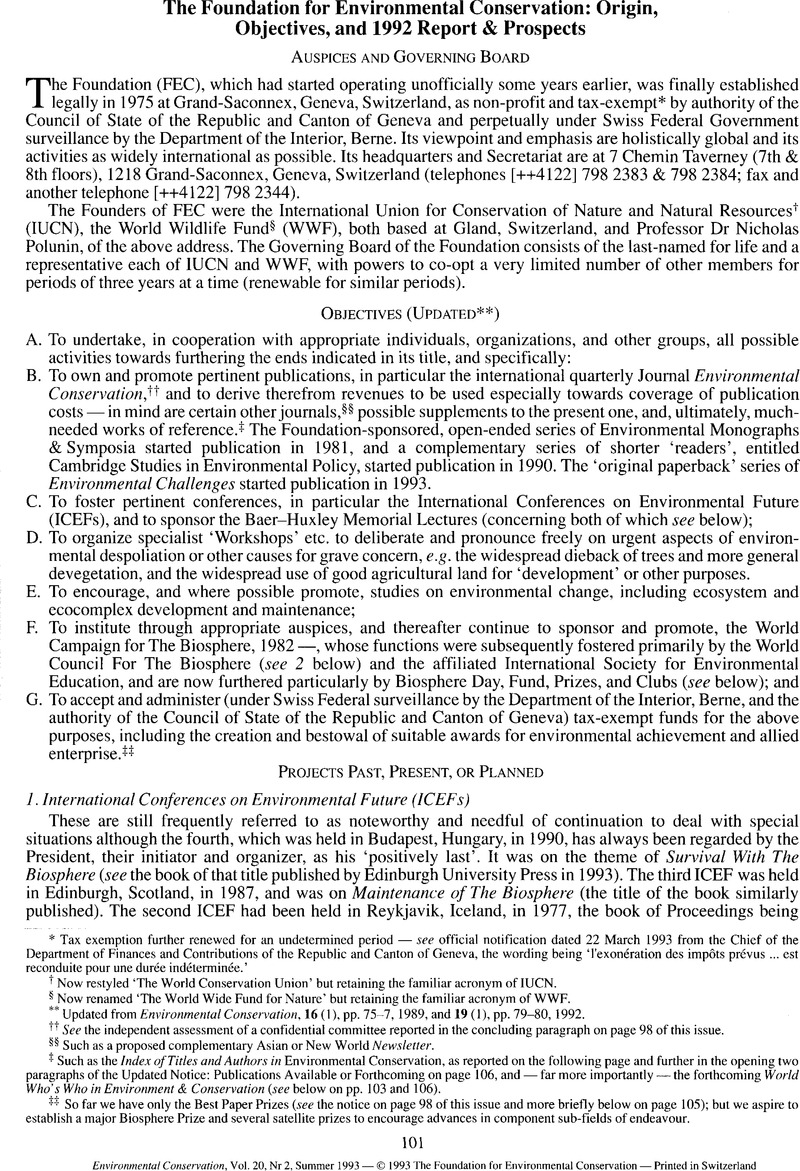No CrossRef data available.
Article contents
The Foundation for Environmental Conservation: Origin, Objectives, and 1992 Report & Prospects
Published online by Cambridge University Press: 24 August 2009
Abstract

- Type
- Editorial Section
- Information
- Copyright
- Copyright © Foundation for Environmental Conservation 1993
References
* Tax exemption further renewed for an undetermined period — see official notification dated 22 March 1993 from the Chief of the Department of Finances and Contributions of the Republic and Canton of Geneva, the wording being ‘l'exonération des impôts prévus … est reconduite pour une durée indéterminée.’
† Now restyled ‘The World Conservation Union’ but retaining the familiar acronym of IUCN.
§ Now renamed ‘The World Wide Fund for Nature’ but retaining the familiar acronym of WWF.
** Updated from Environmental Conservation, 16 (1), pp. 75–7, 1989, and 19 (1), pp. 79–80, 1992.Google Scholar
†† See the independent assessment of a confidential committee reported in the concluding paragraph on page 98 of this issue.
§§ Such as a proposed complementary Asian or New World Newsletter.
‡ Such as the Index of Titles and Authors in Environmental Conservation, as reported on the following page and further in the opening two paragraphs of the Updated Notice: Publications Available or Forthcoming on page 106, and — far more importantly — the forthcoming World Who's Who in Environment & Conservation (see below on pp. 103 and 106).
‡‡ So far we have only the Best Paper Prizes (see the notice on page 98 of this issue and more briefly below on page 105); but we aspire to establish a major Biosphere Prize and several satellite prizes to encourage advances in component sub-fields of endeavour.
* See ‘Notice: WCB and FEC’, Environmental Conservation, 19 (4), p. 296, 1992Google Scholar. However, as we go to press it looks as though the International Green Cross, recently founded under the Presidency of Mikhael Sergeyevich Gorbachev and planned to operate from Geneva and The Hague, may well be taking over the last-remaining major intended function of WCB, namely approaching decision-makers and influencing governments regarding impending dangers or ameliorative chances.
† See pages 90–91 of our preceding issue (20[1], 1993).
* See ‘Biosphere Day’, Environmental Conservation, 19 (3), p. 194, Autumn 1992.Google Scholar
‡ ‘Biosphere Day and Its Needed Fund and Prizes’, ibid., p. 193.
** ‘Introducing Biosphere Clubs’, idem, 20(1), p. 3, Spring 1993.
†† Here we cannot help thinking of our Editorial in the current issue (Environmental Conservation, 20[2], p. 97, 1993).Google Scholar
§ With some additional projects and proposals but following in sequence the items (a)—(i) under this heading in the latest preceding published account of FEC (in Environmental Conservation, 17[2], pp. 175–7, 1990).Google Scholar
† See ‘Background statement of global project: Human-caused soil-ecological changes and their effect on The Biosphere’, by Dmitrieva, Vera A., Kovda, Victor A., Nicholas, Polunin & Pachebsky, Yakob A., Environmental Conservation, 18(3), p. 197, Autumn 1991CrossRefGoogle Scholar; also ‘Revision of map of ecoregions of the world’, by Vladimir N. Bashkin & Robert G. Bailey, idem, 20(1), pp. 75–6, 1993. It is hoped soon to arrange for the participation of another appropriate world body in this major project.
† See Professor Peter J. Catania's note: ‘International Energy Foundation (IEF) Headquarters Move to Geneva’, published on page ??? of this issue.
** And, as we go to press, a request to ‘co-sponsor, without any financial commitment’, a ‘1st International Scientist and Technologist Congress & Convention’ late this year in seemingly all the main hotels of Singapore.
* See ‘Revision of Map of Ecoregions of the World (1992–95)’, by Professor Bashkin, Vladimir N. & DrBailey, Robert G.Environmental Conservation, 20(1), pp. 75–6, 1993.CrossRefGoogle Scholar
† See Environmental Conservation, 20 (1), pp. 90–1, 1993.Google Scholar
** See Environmental Conservation, 15 (2), pp. 187–9, 2 figs, 1988, and cf. 16(3), pp. 280–2, 3 figs, 1989.Google Scholar


